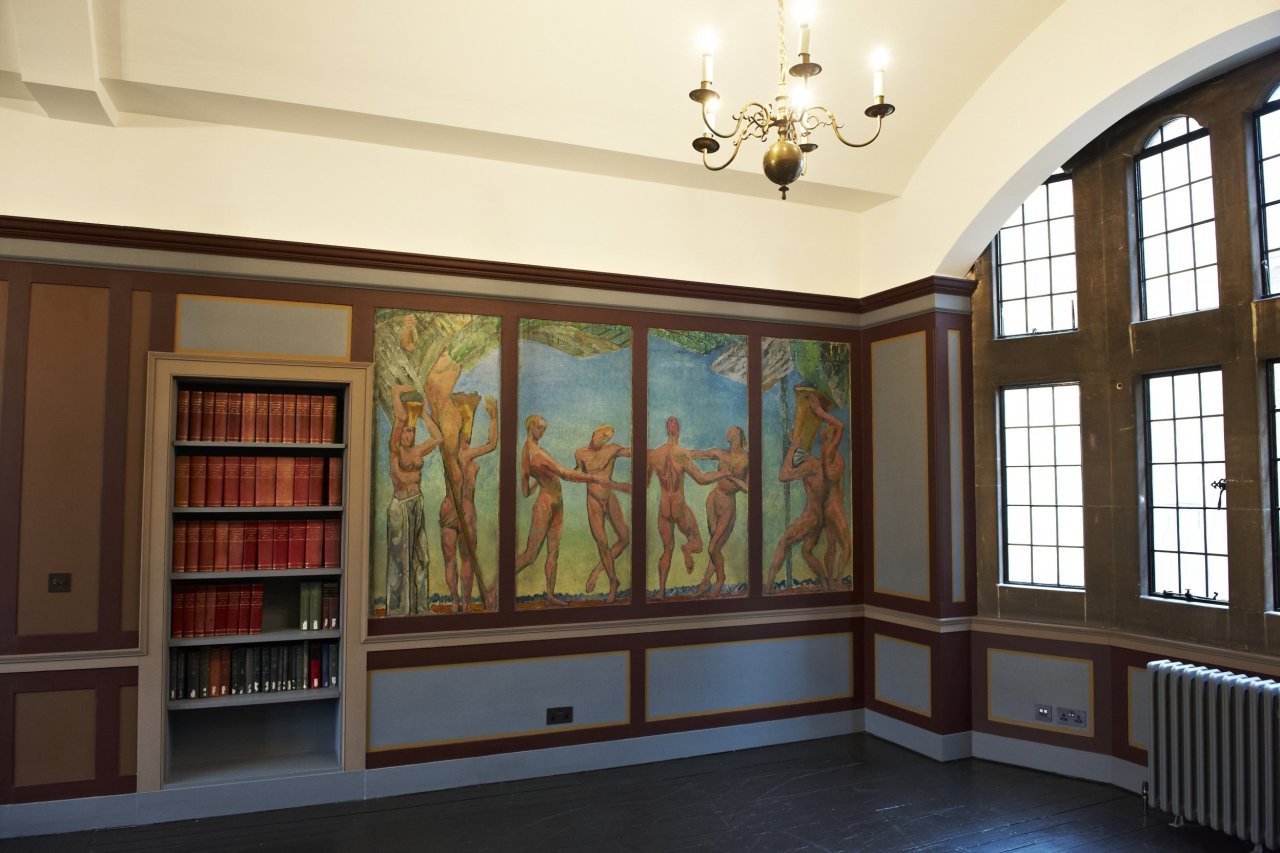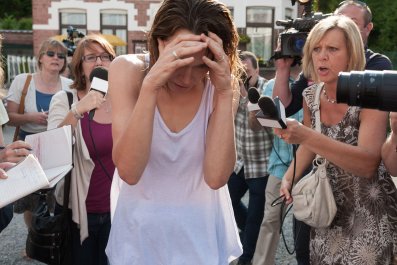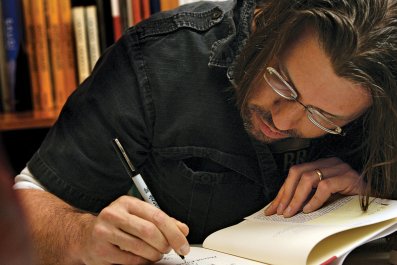Four naked revelers hold hands and dance in the sunshine. To their left, another naked figure balances on a ladder while harvesting grapes and dropping them into baskets held by fellow workers in various stages of undress. On their right, two other nude grape pickers wrestle with a basket.
It's a large, colorful and startling painting. Not the artist's best work, as he admitted, but to art historians an unearthed treasure of incalculable value.
Like a long-lost Shakespearean manuscript or a forgotten Beatles tape, this mislaid mural by the British painter Duncan Grant has lovers of Postimpressionism in paroxysms of delight. Unseen for nearly a century, it was revealed recently on a wall in King's College, Cambridge, when eight other large paintings by Grant and his partner, Vanessa Bell, were removed for restoration.
But how did a 20th century masterpiece find itself on the walls of an office used by economics lecturers? And what was the esteemed artist Duncan Grant doing decorating the walls of a humble college room?
The story starts with that intellectual pre-jet set that became known as the Bloomsbury Group. The writer Virginia Woolf, her husband Leonard, her sister Vanessa Bell and their friends Lytton Strachey, Roger Fry and others, formed an intellectual powerhouse in early 20th century England. They were prodigiously creative—writing, painting, designing and debating in a way that influenced art and literature for decades.
Dorothy Parker quipped that they painted in circles, lived in squares and loved in triangles. And their domestic and personal lives reflected their iconoclastic attitudes to the intellectual and moral norms of the time. They were forever hopping in and out of bed with each other, barely thinking of which sex they nominally belonged to and carefree in a hedonistic, almost-hippie way. Socially, think of them as the Fleetwood Mac of their age.
Into this group drifted the talented young artist Duncan Grant, born in Scotland but educated in English private schools. Through his cousin, Strachey, with whom he had a brief affair, he was introduced to the man who oiled the wheels of the Bloomsbury Group and kept it financially secure, the now legendary economist John Maynard Keynes.
In any list of the greatest minds or the most influential people of the last century, Keynes is right at the top. His analysis of global economics after World War I, published as The Economic Consequences of the Peace, became a best-seller and his The General Theory introduced the notions of government intervention in markets and investment to stimulate growth that came to be characterized as Keynesian.
Not content with saving the world from further economic disaster, and founding the International Monetary Fund and the World Bank, he found time to be the first chairman of the Arts Council of Great Britain and to build the Arts Theatre in Cambridge.
In these days of TMZ, CCTV and social media, it is hard to imagine a world where a distinguished government adviser and civil servant could live such a rakish life. Homosexuality was illegal in Britain until 1967. But before the Soviet spy scandal in the 1950s involving Kim Philby, Guy Burgess and Donald Maclean, it was quite permissible to be a member of the secret Cambridge society The Apostles, conduct any number of gay relationships and hang out with anti-establishment, possibly seditious artists.
And Keynes didn't just throw himself into the Bloomsbury lifestyle, he bankrolled it, working hard as an investor, some would say speculator, to fund the writing, painting and studying of his Bloomsbury chums.
Duncan Grant was 23 and studying at the Slade School of Fine Art, which forms part of University College in the area north of the British Museum known as Bloomsbury, when in 1908 he met 25-year-old Maynard Keynes. They formed an immediate attachment and shared rooms first in St John's Wood, then in Fitzroy Square and later Brunswick Square in Bloomsbury.
Keynes was enchanted by young Grant's enthusiasm for travel and for painting. During the next few years they visited the Orkneys, France, Turkey and Greece, where Grant first witnessed grape and lemon harvests. Throughout this period Keynes retained his association with Cambridge University and, as a fellow, was given a suite of three rooms in Webb's Court, just off the main square of King's College.
The painters of Bloomsbury believed art should never be confined to the canvas and the conventional picture frame. They painted anything and everything. Cupboard doors, fireplaces, shelves, vases, any surface which could be decorated was daubed in their preferred bright colors.
So Keynes's instinctive reaction to the bare walls of his new rooms was to ask his lover to cover them with art. Grant was entranced by the idea of capturing rhythm and movement. In London's Tate Gallery you can see two of his paintings, which explore the same theme. The Dancers depicts four naked and partly dressed figures holding hands, just like the characters he painted for Keynes. In The Lemon Gatherers, five women chat, inspect their feet and balance on their heads baskets which look just like the ones in Keynes's mural.
When his journey into this area of expression was finished, Grant would be hailed as a pioneer of the Postimpressionist movement. But it was a hard ride. Sixty years later, recalling his work on Keynes's room, he told Richard Shone that he "ran into difficulties towards the completion of the painting" and remembered "throwing down his brushes and bursting into tears."
Grant's biographer Frances Spalding, professor of art history at Newcastle University, says the Webb's Court painting is "an important work which demonstrates the importance of rhythmic movement to the Postimpressionists." It's "an effort to find a modern visual language to express traditional ideas of animating human figures which stretched back to the renaissance."
Spalding sees echoes of the 15th century Italian painter Piero della Francesca, particularly his depictions of dancing groups, and also of Henri Matisse, whom Grant had met a few months earlier in Paris. Some of the figures in Matisse's La Danse (1909) are uncannily similar to Grant's painted in 1910.
There is no evidence of the great economist's reaction to the mural, but his decision 10 years later to commission four paintings by Grant and four by Vanessa Bell to hang on either side of his door and obscure the original suggests that neither he nor Grant were too enamored of the work. By this time Grant's affair with Keynes had ended and Grant had formed a partnership with Bell.
In 1925, Keynes met and married the celebrated Russian ballerina Lydia Lopokova. He took rooms elsewhere in Cambridge, but retained his Webb's Court set of rooms until his death in 1946. His large and extremely valuable collection of paintings was bequeathed to King's College and many of them are now on show at the Fitzwilliam Museum in Cambridge.
Professor Jean Michel Massing, director of studies in art history, lives in King's College in rooms decorated floor to ceiling by paintings, some of which are part of the Keynes bequest. The bedroom and dressing room/bathroom have been converted for use as shared offices by the college's economics department. The books on the shelves include several bound volumes of the Economics Journal, which Keynes edited between 1912 and 1944, bulked out by books rescued from a skip when they were deemed surplus to requirement by the college library.
Aytek Erdil, director of studies in economics at Kings, lived in Keynes's rooms before they were converted and still uses them occasionally for seminars and meetings. He might be expected to be in awe of his legendary predecessor and the world-changing conversations that must have been had within the walls of P3 Webb's Court.
Curiously, though, he is dismissive of Keynes's academic legacy and never liked the paintings. But other members of Kings are much more positive. The first bursar, Keith Carne, confirms that King's is keen to support research following in its benefactor's tradition and happy to show the rooms to people.
It might seem incongruous that an obsessive number-cruncher and policy wonk like Keynes would be interested in painting, but the celebrated economics professor Victoria Chick sees no inconsistency. "Culture and civilization," she says, "are what economics is for."


























